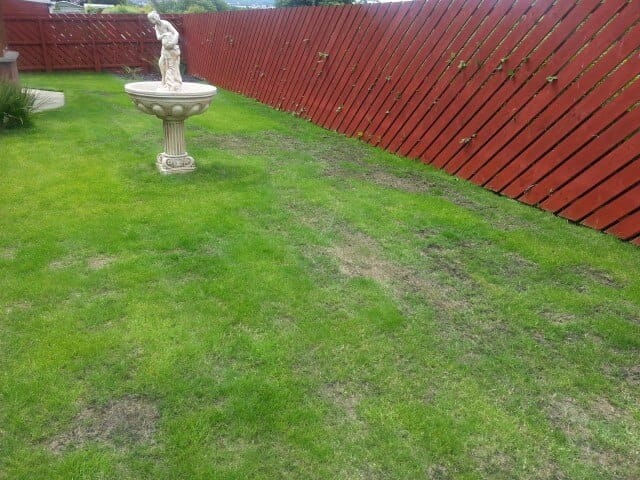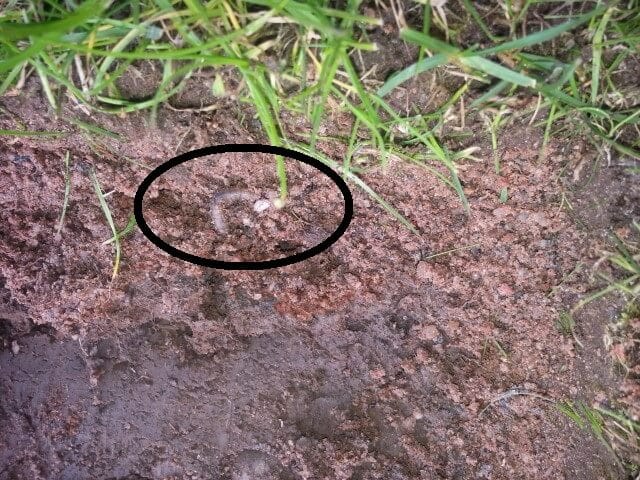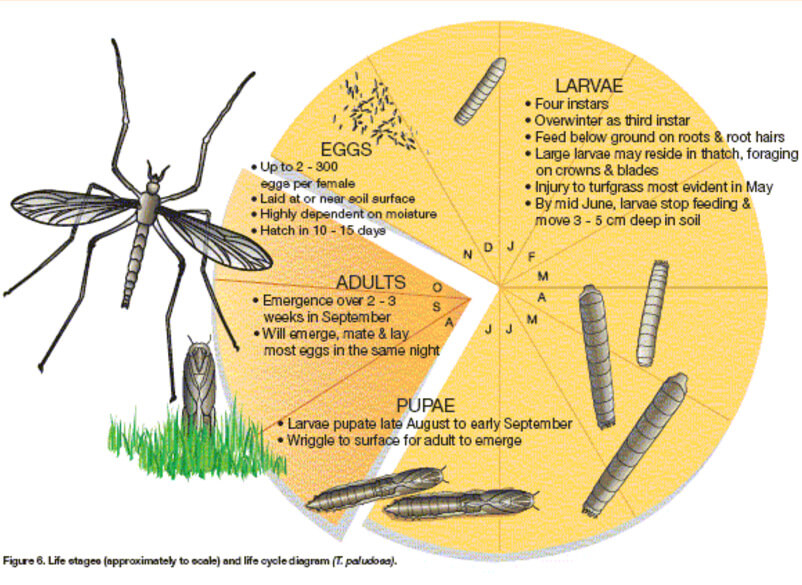You’d be surprised at how much havoc something as small as leatherjackets can create. In this blog we learn more about these creatures and how best to control them.
The damage that Leatherjackets do to a lawn is most obvious in late winter or early spring, so why am I writing about them in August? Well, like so many things in nature, in order to control them we need to understand them. And the lifecycle of the leatherjacket starts in summer.
What is a leatherjacket?
A leatherjacket is the laval stage of the crane fly or daddy long-legs. Tipula paludosa. All insects change shape and feeding habits during their lifetime. Bluebottles are maggots before they’re flies. Butterflies are caterpillars, and crane flies are leatherjackets. We refer to the grubs as lavae. And the job of the lavae is to eat, eat and eat some more before metamorphosing into an adult who will mate, lay eggs and continue the cycle of life.

You’re probably familiar with maggots. They like to eat rotting rubbish. Caterpillars are fussy eaters, and depending on the species will stick to eating the leaves of one type of plant. And boy do they eat a lot! If you’ve ever had your cabbage patch raided by caterpillars you’ll know how much they can put away in a day. Leatherjackets feast on the roots of grass plants. Which is why they’re not particularly welcomed by lawn lovers.
What are the signs that you have leatherjackets in your lawn?
Between August and April you will probably have no idea that there are leatherjackets in your lawn. They remain underground, quietly chewing on the roots of your lawn. However, they are tiny, so the amount they eat is easily replaced by a healthy grass plant.
From late April through to Early June though, the beasts start to grow fast. And to do that they need to eat lots. Your grass plants will be unable to re-grow their roots fast enough and so the plants will perish.
You will see areas of yellowing grass. When you tug on the blades, the plant will come away from the soil all too easily and there will be barely any root on the bottom of the plant.
Birds are another clue. If you having more feathered visitors than normal and they’re all busy scratching and pecking at the lawn, there’s a good chance they’re after eating the grubs.

How to check
Water the area really well. I mean really well, soak it. Now put a big piece of thick black polyethene over the area and hold it down with some bricks. Leave it overnight. In the morning, peel back the polyethene and if there are any leatherjackets lurking, you’ll see them stuck to the poly or sitting on the surface of the lawn.
One or two won’t hurt but if you see a lot of them, or if you are at all worried, give me a call straight away.

The lifecycle of leatherjackets
An adult crane fly emerges from the ground in summer time. It will usually mate, lay eggs and die within 48 hours.
The female likes to lay eggs on grassland or lawns – because that way the young will have plenty to feast upon. She lays up to 300 eggs which will hatch into miniscule grubs 10-15 days later. The grubs have 4 life stages and interestingly enough, the first of them is believed to be highly dependent on water…hold that thought.

The life cycle of the leatherjacket and it’s adult form, the european crane fly. Image from www.northeastipm.org
The lavae grow fast in autumn, slower in winter and faster again in spring. When the soil warms up they feed voraciously on grass roots and that’s when we see the most damage. In around May, the grubs will stop eating, pupate and emerge from their burrows in summer time as crane flies.
Interrupting the life cycle to minimise damage
There are currently no chemical treatments to kill off leatherjackets. So as lawn lovers, we are limited to two types of treatment. A biological treatment and of course, disturbing the life cycle so that we limit their lifespan.
Biological controls: nematodes
The soil beneath your lawn is like a very busy city, teaming with all sorts of life forms. Amongst those creatures are the good microbes that help grass plants survive and the nasties that cause problems for us if they get out of control. It’s a dog eat dog world down there with goodies eating baddies and vice-versa. Amongst the populations are very small worms known as nematodes. There are innumerable species of nematode. Some good some bad. But the ones we’re interested in right now are called Steinernema feltiae. These little fellas have an appetite for leatherjackets. They climb inside them, release bacteria that kill their host. It’s gruesome but it works to our advantage.
If, in the course of caring for your lawn, you suspect that leatherjackets are lurking, you can treat the lawn with nematodes. It sounds ideal – but there is a “but”. Nematodes work best in warm moist soil and on very small leatherjackets. If the conditions are wrong – the results can be disappointing.
Would I use Nematodes?
I consider nematodes an investment. But just like any other investment, you need to weigh up the risks before you put your money in.
IF you see a lot of crane flies getting busy on your lawn in summer AND the weather forecast is good for the next few weeks then yes, nematodes are probably a good idea. Are they a guarantee that your lawn won’t be destroyed next spring? No. There are no guarantees in nature – only risk assessment and management.

An adult female crane fly can lay up to 300 eggs in your lawn. Her eggs will hatch into leatherjackets which live just below the surface of the grass for up to 11 months.
Management tips to protect your lawn against leatherjackets
Remember a few paragraphs ago that I mentioned the importance of water to the first life stage of leatherjackets?
If they need to be in damp soil, it follows that well drained lawns are less vulnerable to attack. So by keeping up to date with aeration, topdressing and scarification, you are reducing the risk.
Here’s an interesting fact:
- A healthy lawn can tolerate up to 40 leatherjackets per square foot without seeing too much damage
- A stressed lawn will only tolerate around 15 leatherjackets per square foot
Now, those figures have come from an organisation in the North East of America where grass species and the climate are a little different to here in Ireland. I’d be inclined to be a lot more cautious about the actual populations but I definitely agree that healthy lawns are better at withstanding an invasion of pests or diseases. They also recover quicker from an attack.
Here’s the Premier Lawns NI plan of action for leatherjackets:
This is a regular management plan which becomes super important if you see lots of daddy long-legs in your garden (or if you’ve been on holiday and suspect they’ve visited whilst you were away)
- Scarify to remove any eggs or little lavae that are lurking in the thatch layer.
- Aerate to thoroughly disturb the soil and to improve drainage
- If you are confident that soil temperature will stay above 12 degrees for the next 4-5 weeks, apply nematodes
- Make sure your lawn has a good feed in early autumn and another in mid winter. It’s vital that you keep those roots strong enough and vigorous enough to outgrow any damage.
- Keep an eye out for any signs that you may have leather jackets in your lawn (yellowing grass, lots of activity from birds) and call me as soon as you’re worried. Word on the tees is that there is a leatherjacket treatment being developed as I type – but so far we don’t know when it will be released or even where in the world that will be. I can’t wait to hear!
Buy Nematodes / leather jacket killers here
Learn more about lawn nutrition: what to apply, when and why
If you are at all worried about your lawn – contact Robbie for a free lawncare assessment
Moss in your lawn? Take action against shade by trimming hedges and shrubs over the winter period.
